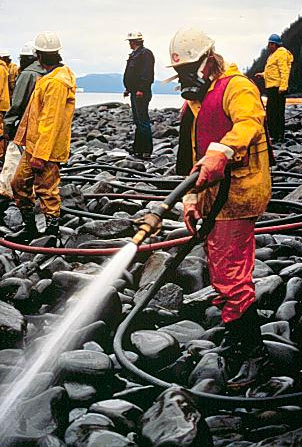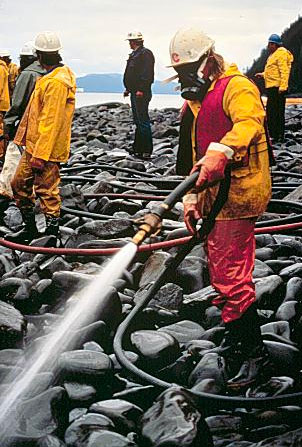 The massive clean-up efforts for the 1989 Exxon Valdez disaster in Prince William Sound. (Photo courtesy of the Exxon Valdez Oil Spill Trustee Council) “A senior BP executive conceded Tuesday that the ruptured oil well in the Gulf of Mexico could conceivably spill as much as 60,000 barrels a day of oil, more than 10 times the estimate of the current flow,” reports The New York Times today, about a closed-door briefing for members of Congress.
The massive clean-up efforts for the 1989 Exxon Valdez disaster in Prince William Sound. (Photo courtesy of the Exxon Valdez Oil Spill Trustee Council) “A senior BP executive conceded Tuesday that the ruptured oil well in the Gulf of Mexico could conceivably spill as much as 60,000 barrels a day of oil, more than 10 times the estimate of the current flow,” reports The New York Times today, about a closed-door briefing for members of Congress.
As oil gushes from the Gulf sea bottom, it’s interesting to ponder what past spills have done to ecoystems. Under the right — or, better said, the wrong — conditions, oil can linger for decades and longer, causing permanent damage. How is Prince William Sound, site of the Exxon Valdez disaster, doing these days? From MSNBC:
Twenty years after the Exxon Valdez spilled 11 million gallons of crude oil in Alaska’s Prince William Sound, oil persists in the region and, in some places, “is nearly as toxic as it was the first few weeks after the spill,” according to the council overseeing restoration efforts.
“This Exxon Valdez oil is decreasing at a rate of 0-4 percent per year,” the Exxon Valdez Oil Spill Trustee Council stated in a report marking Tuesday’s 20th anniversary of the worst oil spill in U.S. waters. “At this rate, the remaining oil will take decades and possibly centuries to disappear entirely.”
… Moreover, surveys “have documented lingering oil also on the Kenai Peninsula and the Katmai coast, over 450 miles away,” according to the council.
None of that was expected “at the time of the spill or even ten years later,” it added. “In 1999, beaches in the sound appeared clean on the surface. Some subsurface oil had been reported in a few places, but it was expected to decrease over time and most importantly, to have lost its toxicity due to weathering. A few species were not recovering at the expected rate in some areas, but continuing exposure to oil was not suspected as the primary cause.”
It turns out that oil often got trapped in semi-enclosed bays for weeks, going up and down with the tide and some of it being pulled down into the sediment below the seabed.
Another tragic example involves the 1969 spill off the Massachusetts coast at West Falmouth, the effects of which linger 40 years later. By 2002, scientists had concluded that toxic oil traces would “persist indefinitely” in the coast’s marshes, in some cases at concentrations similar to those “observed shortly after the spill.”
A 2002 study by British researchers addressed the long-term effects of spills thusly:
Oil contamination may persist in the marine environment for many years after an oil spill and, in exceptional cases such as salt marshes and mangrove swamps, the effects may be measurable for decades after the event. However, in most cases, environmental recovery is relatively swift and is complete within 2-10 years. Where oil has been eliminated from the scene, the long-term environmental impacts are generally confined to community structure anomalies that persist because of the longevity of the component species.
There are two things that should chill us about that assessment. If mangrove swamps are exceptionally vulnerable to oil spills, the BP disaster could not have happened in a worse place. The Gulf is home to the only mangrove swamps in the continental United States. Concentrated in coastal south Texas, Louisiana, and Florida, our mangrove wetlands are already under enormous pressure from upstream dams and development. The importance of mangrove swamps has been well established. “They function as nurseries for shrimp and recreational fisheries, exporters of organic matter to adjacent coastal food chains, and enormous sources of valuable nutrients,” says the EPA. “Their physical stability helps to prevent shoreline erosion, shielding inland areas from severe damage during hurricanes and tidal waves.”
The second bone-chiller from the 2002 study is the bit about “where oil has been eliminated from the scene.” The Gulf leak is now spurting at the rate of at least 5,000 barrels a day, and as we just learned, that rate could increase dramatically. The situation looks likely to persist for three months. BP’s main strategy is not so much to remove the oil but rather to disperse it with chemicals. Like Prince William Sound’s, the Gulf’s troubles may be only just beginning when the well is finally plugged up.




